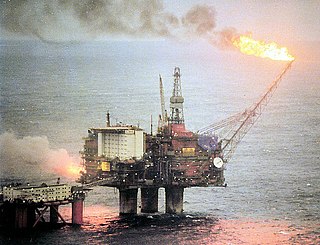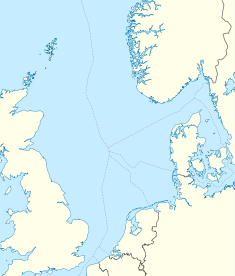
North Sea oil is a mixture of hydrocarbons, comprising liquid petroleum and natural gas, produced from petroleum reservoirs beneath the North Sea.

Ekofisk is an oil field in block 2/4 of the Norwegian sector of the North Sea about 320 km (200 mi) southwest of Stavanger. Discovered in 1969 by Phillips Petroleum Company, it remains one of the most important oil fields in the North Sea. This was the first discovery of oil after the drilling of over 200 exploration wells in the North Sea "triggered" by the Groningen gas field discovery. In 1971, Phillips started producing directly to tankers from four subsea wells. Oil production is planned to continue until at least 2050.

The Statfjord oil field is a large oil and gas field covering 580 km2 in the U.K.-Norwegian boundary of the North Sea at a water depth of 145 m, discovered in 1974 by Mobil and since 1987 operated by Equinor.

Gullfaks is an oil and gas field in the Norwegian sector of the North Sea operated by Equinor. It was discovered in 1978, in block 34/10, at a water depth of 130-230 meters. The initial recoverable reserve is 2.1 billion barrels, and the remaining recoverable reserve in 2004 is 234 million barrels. This oil field reached peak production in 2001 at 180,000 barrels per day (29,000 m3/d). It has satellite fields Gullfaks South, Rimfaks, Skinfaks and Gullveig.
Oseberg is an offshore oil field with a gas cap in the North Sea located 140 km (87 mi) northwest of the city of Bergen on the southwestern coast of Norway. The field, which is 25 km long by 7 km wide, was discovered in 1979 and its development is known to be one of the significant milestones in emergence of Norway's independent oil and gas industry. The Oseberg field was named after Oseberg ship, one of Norway's most significant archeological discoveries. The ancient Viking ship from the early 9th century was discovered in a 1904 historical excavation of a burial mound at the Oseberg Farm, south of Oslo.

Troll is a natural gas and oil field in the Norwegian sector of the North Sea, one of the biggest in the North Sea, holding 40% of Norway’s gas – it also possesses significant quantities of oil, in thin zones under the gas cap, to the west of the field. The field as a whole consists of the main Troll East and Troll West structures in blocks 31/2, 31/3, 31/5 and 31/6, about 65 kilometres (40 mi) west of Kollsnes, near Bergen. Most of the gas lies in Troll East.

The Piper oilfield is a substantial North Sea oilfield covering 30.1 km2. It lies roughly halfway between Aberdeen and Bergen, at the eastern end of the Moray Firth basin. Oil extracted from it is piped to Scotland, where it is stabilised at an oil plant on the island of Flotta, in the Orkney archipelago, while gas is shipped via the Frigg gas pipeline. In June 1975, the Piper Alpha oil platform was placed over the field in 144 metres of water, secured in place by 24 piles extending 116 metres beneath the seabed. The platform was designed for simultaneous drilling and production. Piper Alpha was the site of one of the world's worst oil platform disasters when it was destroyed by an explosion in 1988, with the loss of 167 lives. Piper Bravo was installed in 1992. Talisman Energy acquired a controlling interest in 2000.
This is an overview of Equinor's operations in various countries. Equinor is a Norwegian petroleum company.

Norway is a large energy producer, and one of the world's largest exporters of oil. Most of the electricity in the country is produced by hydroelectricity. Norway is one of the leading countries in the electrification of its transport sector, with the largest fleet of electric vehicles per capita in the world.

The Forties Oil Field is the second largest oil field in the North Sea, after the Clair oil field, which is located 110 miles east of Aberdeen. It was discovered in 1970 and first produced oil in 1975 under ownership of British Petroleum, now called BP.

Equinor ASA is a Norwegian state-owned multinational energy company headquartered in Stavanger. It is primarily a petroleum company operating in 36 countries with additional investments in renewable energy. In the 2020 Forbes Global 2000, Equinor was ranked as the 169th-largest public company in the world. As of 2021, the company has 21,126 employees.

Hydro Oil & Gas is a defunct division of Norsk Hydro that operated within the oil and gas industry. On October 1, 2007 it merged with Statoil to form the new corporation StatoilHydro.
Heimdal is an offshore natural gas field in the North Sea located 212 kilometres (132 mi) northwest of the Stavanger, Norway. Heimdal serves as a connection hub for processing and distribution of natural gas from satellite fields.
Skirne which also includes the Byggve deposit is an offshore gas field in the North Sea located 24 kilometres (15 mi) east of the Heimdal gas field and 140 kilometres (87 mi) from Stavanger, Norway. The depth of the water in the field area is 120 metres (390 ft). Both Skirne and Byggve are considered satellites to Heimdal field and are connected to it by subsea pipelines. TotalFinaElf which is the operator had received the approval from Norwegian Ministry of Petroleum and Energy for development of the fields in 2002. The company holds 40% interest in the project. Other stakeholders are Petoro and Centrica. Both Skirne and Byggve have an estimated 230 billion cubic feet of natural gas and about 10 million barrels of condensate, combined.
The Johan Sverdrup oil field is an oil field in the North Sea, about 140 kilometres (87 mi) west of Stavanger, Norway. The field lies in two different production licenses and consists of two different discoveries called Avaldsnes and Aldous Major South. When it was revealed that these discoveries constituted one single field, it was renamed Johan Sverdrup after the father of Norwegian parliamentarism. The field has not yet been unitized between production licenses 501, 501B, and 265. Johan Sverdrup is expected to hold 1.9–3.0 billion barrels of oil. According to Statoil, the field is in 110 to 120 metres water depth, and the reservoir is at 1900 meters depth.
The Rosebank oil and gas field lies west of Shetland. It is operated by Equinor; Suncor and Siccar Point Energy. The discovery well was drilled in 2004. A final investment decision for Rosebank is planned to be taken by May 2022. In 2022, Siccar Point Energy has been acquired by Ithaca Energy, a daughter company of Delek Group.
Wushi Oil Field is an oil and gas field located in the South China Sea Exclusive Economic Zone, 30 miles from Zhanjiang, off the southern coast of Guangdong, China.
The Claymore oil field is located in Block 14/19 on the United Kingdom's Continental Shelf. It is 161 km (100 mi) northeast of Aberdeen in the Central North Sea. The field is named after a double-edged broadsword used by Highland Scots. Recoverable oil reserves were estimated to be 511 million barrels from an initial oil in place of 1452.9 million barrels. The field was developed through a large steel jacket platform standing in 110 m of water. A separate accommodation platform was installed in 1995. Fluid production was supported by gas lift and significant water injection. The production platform also supports production from the Scapa field, the Golden Eagle field and the Tartan field. Oil is exported to the Flotta terminal.
Alwyn North is a major oil and gas field in the United Kingdom sector of the northern North Sea, 160 km east of the Shetland Islands. The field was developed through two bridge-linked offshore platforms and a number of subsea satellite wellheads. Alwyn North has been producing oil and gas since 1987 and is still (2021) in operation.











